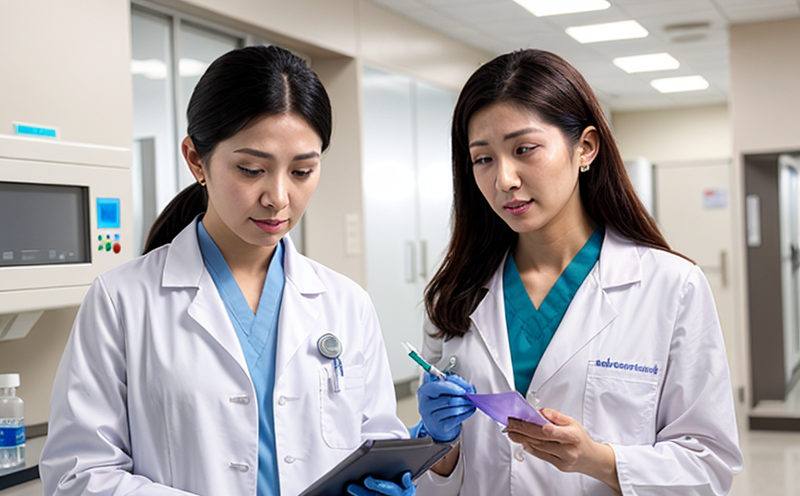Comparative Glycosylation Testing of Biosimilars
In the pharmaceutical industry, biosimilars have emerged as a critical component of healthcare solutions. The development and testing of these complex biologics require meticulous attention to detail, particularly in ensuring their safety and efficacy. Comparative glycosylation testing plays a pivotal role in this process by allowing researchers and regulatory bodies to assess the structural similarity between reference products and biosimilars.
Glycosylation refers to the addition of carbohydrate moieties to proteins or lipids, which can significantly influence the biological activity, stability, and immunogenicity of biopharmaceuticals. Comparative glycosylation testing involves a series of analytical techniques aimed at characterizing the glycans attached to the primary structure of these molecules. This process is essential for ensuring that biosimilars are sufficiently similar to their reference products, thereby reducing the risk of adverse reactions in patients.
The importance of comparative glycosylation testing cannot be overstated. It helps identify potential differences between a biosimilar and its reference product at the molecular level, which can have profound implications for drug safety and efficacy. Regulatory authorities worldwide, including the United States Food and Drug Administration (FDA) and the European Medicines Agency (EMA), mandate this type of testing as part of their approval processes.
The methodology behind comparative glycosylation testing typically involves a combination of advanced analytical techniques such as mass spectrometry (MS), liquid chromatography-mass spectrometry (LC-MS/MS), and capillary electrophoresis with laser-induced fluorescence detection (CE-LIF). These tools enable the precise quantification and structural characterization of glycans, providing detailed insights into their composition and distribution.
Preparation of specimens for comparative glycosylation testing is a critical step that ensures accurate and reliable results. This process involves several key steps, including sample collection, processing, and preparation. Samples are often obtained from bioreactor batches or final product formulations. Proper handling and storage conditions must be maintained to preserve the integrity of the glycans.
Once specimens are prepared, they undergo rigorous analysis using a suite of sophisticated instruments designed to capture comprehensive data on glycan structures. The choice of instrumentation depends on the specific requirements of the study but typically includes high-performance liquid chromatography (HPLC), tandem mass spectrometry (MS/MS), and nuclear magnetic resonance spectroscopy (NMR).
The results from these analyses are then collated and interpreted to compare glycan profiles between biosimilars and their reference products. This comparison helps identify any discrepancies or areas of divergence that may necessitate further investigation or adjustment in the manufacturing process.
Comparative glycosylation testing is not just a technical exercise; it has real-world implications for patient safety and therapeutic outcomes. By ensuring that biosimilars are glycan-structurally similar to their reference products, this testing contributes significantly to maintaining high standards of care within healthcare systems globally.
Applied Standards
The practice of comparative glycosylation testing adheres to a variety of international standards aimed at ensuring accuracy and consistency across different laboratories. Notably, these include:
- ISO 17025: This standard ensures that the laboratory performing the test operates according to recognized best practices in quality management.
- ASTM E2934: This document provides guidelines for analyzing glycans using MS/MS, which is crucial for comprehensive glycan profiling.
- EMA Guideline on Glycoanalytical Method Development and Validation: Developed by the European Medicines Agency, this guideline offers a framework for developing robust methods for comparative glycosylation testing.
These standards not only enhance the reliability of test results but also facilitate easier communication between different laboratories and regulatory bodies, promoting greater consistency in biosimilar development and approval processes worldwide.
Industry Applications
| Application | Description |
|---|---|
| Biosimilar Development | Involves detailed characterization of glycan structures to ensure structural similarity with the reference product. |
| Regulatory Compliance | Satisfies regulatory requirements for biosimilars, ensuring they meet stringent safety and efficacy criteria. |
| R&D Optimization | Aids in refining manufacturing processes to enhance consistency and reduce variability. |
| Patient Safety Monitoring | Identifies potential risks early on, supporting informed decision-making in clinical trials and post-market surveillance. |
- Biosimilar Development: Ensures that glycosylation patterns align closely with those of the reference product, facilitating a seamless transition from development to commercialization.
- Regulatory Compliance: Meets stringent regulatory standards set by agencies like the FDA and EMA, ensuring compliance for market entry.
- R&D Optimization: Provides valuable insights that can lead to process improvements and enhanced product quality.
- Patient Safety Monitoring: Offers critical information during clinical trials and post-market surveillance, helping to mitigate risks associated with structural differences in glycosylation.
The application of comparative glycosylation testing is essential for maintaining the integrity and efficacy of biosimilars. By adhering to these standards and utilizing advanced analytical techniques, laboratories can provide reliable data that supports sound decision-making throughout the lifecycle of biopharmaceuticals.
Customer Impact and Satisfaction
The success of comparative glycosylation testing lies not only in its technical rigor but also in its ability to address the needs of various stakeholders within the pharmaceutical industry. Quality managers, compliance officers, R&D engineers, and procurement teams all benefit from this service:
- Quality Managers: They receive assurance that biosimilars meet strict quality criteria, thus maintaining product consistency.
- Compliance Officers: This testing helps ensure adherence to regulatory guidelines, minimizing the risk of non-compliance issues.
- R&D Engineers: They gain detailed insights into glycan structures, aiding in process optimization and innovation.
- Procurement Teams: Reliable data supports informed procurement decisions, ensuring that only high-quality biosimilars are selected for use.
The benefits extend beyond just internal stakeholders; they also contribute to improved patient outcomes by enhancing the reliability of therapeutic options. Satisfied customers include both pharmaceutical companies and healthcare providers, who rely on accurate and consistent data from comparative glycosylation testing to make informed decisions.





